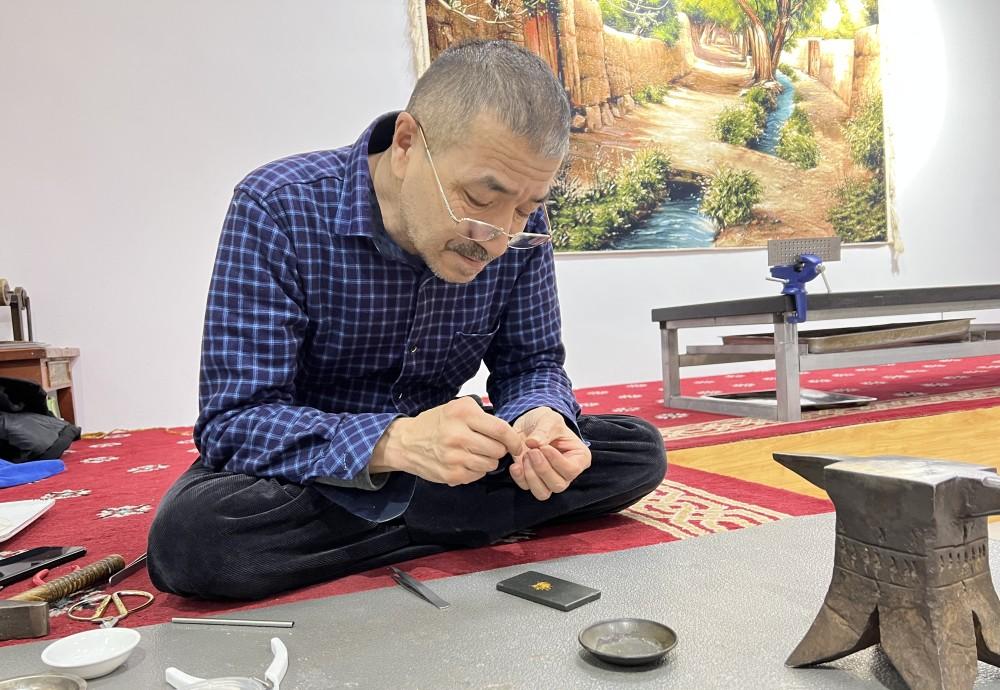Pomegranate Cloud/Xinjiang Daily reporter Guo Qian
Sitting cross-legged on the blanket, the wooden handle hammer and the iron pier in front of him, is the "old man" who has been following for many years, Abdulsitti Abulimiti habitually holds his breath and smacks his mouth, skillfully pinches a section of gold pillar about 1 mm long from the small tray, and exerts force and shapes, and completes the small piece on a pure gold earring.

On February 23, AbdulSit Abulimiti was making gold jewelry. Pomegranate Cloud/Xinjiang Daily reporter Guo Qian
"The manual is time-consuming, and the most common pair of earrings takes two days to complete." On February 23, AbdulSithi raised his head and smiled, his expression and tone revealing the peace and confidence of a 32-year-old goldsmith.
In the Central Asian Gold and Jade Industrial Park in Urumqi, the ancient handicraft workshop of Xinjiang Osmani Gold and Silver Jewelry Processing Co., Ltd. was specially built for Abdul Xiti. He is the only craftsman in the industrial park who can familiarize himself with the Uyghur gold processing and production process.
"I was born in Ush County, and when I was a child, I was fascinated by the gold earrings worn by my grandmother, and when my grandmother hugged me, I couldn't help but touch the pair of dangling, golden earrings on her ears." Abdul Sidhi said that his grandmother's grandfather was a master of the Uyghur gold processing process, but unfortunately no one in the family inherited the craft at that time. What the family did not expect was that a pair of ancestral earrings fascinated him and became a goldsmith who mastered ancient techniques.
At the age of 19, Abdul Sidhiti formally studied the art and began to learn this ancient technique, starting with a gold ring, which was learned for 6 years.
Uyghur gold processing and production technology made of gold products, the process is complex, completely by hand, requiring craftsmen to have higher skills. The production process generally requires the gold nugget to be pulled into gold wire first, and then the gold wire is forged into different shapes such as gold pillars and gold beads. Among them, the most complex is the gold ring, which needs to be tightly wrapped around the gossamer gold wire on the steel mold, making it spring-shaped, and then cut into small sections and bent out of the small circle.
Exquisite ornamental components made by Abdulsit Abulimiti. Pomegranate Cloud/Xinjiang Daily reporter Guo Qian
With these components, the desired shape is then shaped with a gold wire hoop and used as a framework to glue together components of different sizes in different arrangements. Finally, like cumin, pure gold powder containing borax is sprinkled on the jewelry, followed by high temperature heating, taking advantage of the low melting point of borax, and finally various decorative components are fixed and molded, and a finished product is completed.
"A pair of earrings is probably composed of dozens to hundreds of components of different sizes and shapes, and the fineness of handmade products is difficult to achieve by mechanical craftsmanship." Abdul Sidhiti said that he did not have design drawings in the production, and the "look" was in his head.
Gold ornaments made by Abdulsit Abulimiti. Pomegranate Cloud/Xinjiang Daily reporter Guo Qian
Open the mobile phone photo album, which contains hundreds of pictures of jewelry saved by Abdul Sidti, including earrings, necklace pendants and so on. "In the earliest days, there were very few types and appearances, and then while doing it, I thought about it, walking on the road and seeing beautiful styles, or sample drawings sent by customers, basically I can remember it after a few glances." In this way, more and more styles can be made, in addition to pure gold, there are also gold products set with various types of gemstones. Abdul Sidhiti said.
In Xinjiang, there are very few craftsmen like Abdul Xiti who have done all the processes. Most of these ancient gold jewelry are custom-made, and each piece is a single item, which also fully demonstrates the charm of handicraft jewelry. Although there are many varieties of ordinary gold jewelry on the market, there are still many "fans" of this kind of ancient technique of gold jewelry customization. At present, the delivery time of the order on Abdul Siddi's hand has been scheduled two years later.
With exquisite skills, he was hired by Xinjiang Osmani Gold and Silver Jewelry Processing Co., Ltd., which also created better conditions for him to concentrate on making jewelry. In the ancient handicraft workshop, he is not impatient, and for decades he has been refining his skills in jewelry making.
Engaged in the production of gold jewelry for 32 years, Abdul Xiti has brought more than 30 apprentices, 6 of whom have been trained, and opened an independent shop to continue to pass on this technique.
"Handmade jewelry has a temperature, now more and more people like handmade jewelry, such a good skill can not be lost, I will continue to do." Abdul Sidhi said.